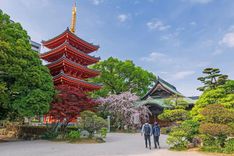Shijō-dōri runs west through the heart of Gion, crossing the Kamo-gawa into Kyoto’s main downtown district. One of its most distinctive landmarks is Minami-za (南座), a historic kabuki theater overlooking the river. Originally established in the early 17th century and last rebuilt in 1929, it hosts a major kabuki festival every December, featuring Japan’s most celebrated actors.
Kabuki has been part of Gion’s identity since the late 16th century, when a female troupe first performed religious dances along the riverbanks. Over time, it evolved into the all-male theater tradition known today, thriving alongside Kyoto’s geisha culture in the city’s famous pleasure quarters. Of these, Gion was the most renowned.
For a glimpse of this historic “floating world,” walk south along Hanamikōji-dōri, where many of the elegant wooden buildings still function as exclusive teahouses where geisha entertain guests. Visit after dark, when red lanterns glow outside their secretive entrances, or come in the early evening for a chance to spot geisha and maiko (apprentice geisha) arriving for their appointments.
Not sure how long to stay in Kyoto to soak in its traditional culture? Plan for at least a few days to experience both its historic sights and living traditions.






